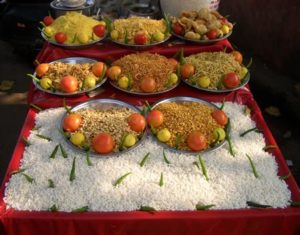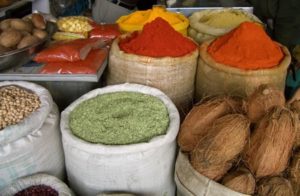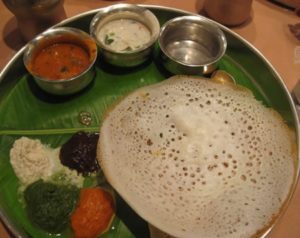The cuisine of India is a result of 5,000 years of history, of interaction between the sub-continent and multiple other outside influences, such as the Mughals, British and Portuguese. Travel the country and you’ll find that each region has their own cuisine – each with its own specialties – based on locally available spices, vegetables, grains and fruits. With the advent of Buddhism, vegetarianism now plays a large role throughout the country and, because cows are sacred to the Hindu religion, the consumption of beef is rare.

Food Staples
- Rice is served with pretty much everything.
- Whole wheat flour is used in the making of flatbreads.
- Lentils, chickpeas, mung beans and other pulses are an integral part of the cuisine. Split pulses are used to create the popular dish, dal. Dal is generally served with rice and flatbreads. Pulses are also ground to create flour, used in the making of dishes such as Idli and Vada. These two items are popular street foods often eaten for breakfast, or as a snack throughout the day.
- Potatoes were brought to India by the Portuguese and are now a staple of the Indian diet.
- Vegetables and fruit are readily available, due to a climate that is conducive to year-round growing.

Indian Spices
Most of us, when we cook an Indian meal, go to the market and buy curry powder. Did you know that curry powder isn’t one spice but is actually a mix of spices? The specific ingredients vary depending on where in India you are. Typical spices found in curry powder include: turmeric, coriander, cumin, fenugreek and chili peppers. In North India, you’ll find a similar spice combination, garam masala.
The chili pepper was also introduced by the Portuguese and often appears in dishes, either whole or ground. Cardamom, also used in many dishes, is the third most expensive spice in the world (after saffron and vanilla) and is grown in India. Other spices frequently used include black mustard seed, ginger, cinnamon, coriander and garlic.

Flatbreads
Breads in India tend to be flatbreads, made from flour and water and rely on yeast spores from the air for fermentation. Chapati, roti, paratha, naan and dosa are just a few of the many types of Indian breads. Breads can be served plain or may come stuffed with potatoes, vegetables or paneer (cheese).
Drinks
- India is one of the largest producers of tea in the world, so it’s no surprise that tea is a popular drink throughout the country. It’s often prepared with milk and a mixture of spices.
- Lassi is a traditional yogurt-based drink, which is prepared by blending yogurt, milk and spices. You’ll sometimes find fruit added.
- Beer continues to grow in popularity, with lager being the most popular brew.
Mouth watering yet? You still have the opportunity to join our North India Culinary tour this fall and experience these complex and diverse tastes for yourself! Call us at (206-317-1860) or Contact Us via email.
Embrace life,
Pat
To stay up-to-date on all things WanderTours, follow us on Facebook and subscribe to our blog via email or RSS.
 Is Travel Insurance Worth It?
Is Travel Insurance Worth It?